|
The Great Railroad Builders
By E. J. Edwards
MUNSEY'S MAGAZINE—FEBRUARY, 1903
THE MEN TO WHOSE GENIUS IS MAINLY DUE THE FACT THAT NEARLY
HALF THE RAILWAY MILEAGE OF THE WORLD IS IN THE UNITED STATES,
AND THAT AMERICAN RAILROADS EXCEL ALL OTHERS IN ECONOMY AND EFFICIENCY
OF OPERATION.
FIFTY years ago the railway mileage of the United States was
approximately five thousand miles. Today that mileage has expanded
to considerably more than two hundred thousand miles. The money
invested in the railways that we had in operation in 1880 was
comparatively a few millions. Today the railway systems of the
United States represent an investment of three billions and a
yearly earning capacity of hundreds of millions.
Within four or five years after the close of the Civil War,
the inventor and the scientist had brought forward the ideas which
have made possible this stupendous expansion of the American railway
systems, and insured the great industrial and commercial growth
of the country. These inventions were the air brake of Westinghouse
the coupler of Janney, and the steel rail, which the Bessemer
process made practicable. Without this equipment it would have
been impossible to open up the great West beyond the Mississippi.
THE FIRST CHAPTER OF RAILROAD HISTORY
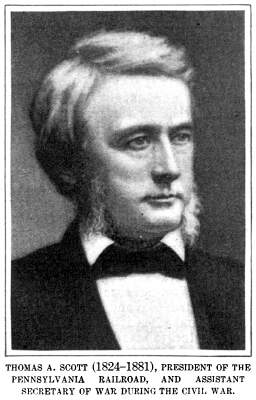 The first era of American railway
development is that measured by the years between 1840 and 1865.
The sole purpose of those who then invested their capital in railway
construction was communication between two or more interior cities,
or between an interior city and tide water. Irregular, short,
independent, and often unconnected railway lines appeared here
and there—almost all of them east of the Alleghanies and
north of the Potomac—prior to 1850. No preeminently great
constructive intellect, no man who fully, perceived and grasped
the opportunity which the United States offered to the builders
of railroads, is identified with that earlier epoch. The first era of American railway
development is that measured by the years between 1840 and 1865.
The sole purpose of those who then invested their capital in railway
construction was communication between two or more interior cities,
or between an interior city and tide water. Irregular, short,
independent, and often unconnected railway lines appeared here
and there—almost all of them east of the Alleghanies and
north of the Potomac—prior to 1850. No preeminently great
constructive intellect, no man who fully, perceived and grasped
the opportunity which the United States offered to the builders
of railroads, is identified with that earlier epoch.
Sheffield, at New Haven, bought a canal, drained off its water,
and constructed a railway upon the mule path, penetrating central
New England as far north as Northampton, Massachusetts. The promoters
of the Erie Railway, whose purpose was to connect the lakes with
tide water, ran their road down to a little landing place upon
the Hudson, built piers to the channel, and then learned one of
the first lessons of the many that were taught in those days.
That was that for the highest development of a railway a harbor
or terminal must be sought, not at any convenient point upon river
or sea, but at some center of commerce or manufacture. And so
one after another the experiences out of which the later generation
have built this colossal railway structure were being furnished
here and there, one by one.
THE MAKERS OF GREAT RAILWAY SYSTEMS
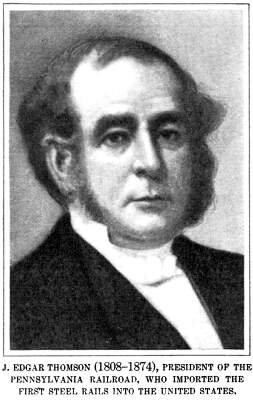 When Westinghouse came forward
with his air brake and Janney with his coupler, and when it was
demonstrated that the steel rail made possible a traffic which
would have been impracticable with an iron rail, then there began
the second era of our railway development. In it the best intellects
and strongest creative forces of the time began to identify themselves
with this most important of all the incidental and artificial
impulses that have made the United States a world power. When Westinghouse came forward
with his air brake and Janney with his coupler, and when it was
demonstrated that the steel rail made possible a traffic which
would have been impracticable with an iron rail, then there began
the second era of our railway development. In it the best intellects
and strongest creative forces of the time began to identify themselves
with this most important of all the incidental and artificial
impulses that have made the United States a world power.
Not in any one man were combined, in their finest development,
the three distinctive capacities that have created and perfected
our gigantic railway system. These three intellectual forces were
genius for finance, engineering ability, and mastery of the complex
details which the operation of a railway system involves. In some
one of these three all the forces conspicuously identified with
our railway development were trained. Commodore Vanderbilt combined
two of them. He was trained in early life as a common carrier,
although by water rather than by land, and he was also a self
schooled, self reliant, and eminently successful financier. But
he did not possess in a high degree the scientific or engineering
ability, nor would he have ever been personally very successful
as a practical operator.
To the south the elder Garrett, an operator taught in the first
railway epoch, and a man of some prophetic vision, had by inspiration
learned that a greater career than that of a mere coal carrier
for the benefit of Baltimore was possible for the Baltimore &
Ohio Railroad. He took his line over the Appalachian range, at
whose foothills it had stopped, and brought it to a terminus upon
the Ohio River. In Pennsylvania J. Edgar Thomson, and afterward
Thomas A. Scott, had a broader vision than that possessed by Mr.
Garrett. They foresaw the possibilities of the Ohio and the Mississippi
valleys, and perceived that the highest development of the Pennsylvania
system was dependent upon the mastery of lines that bisected Ohio
and reached towards the Northwest, terminating at Chicago.
THE GENIUS OF CORNELIUS VANDERBILT
About that time, Commodore Vanderbilt made evident his constructive
statesmanship by his purchase of various little railway lines
in New York State. By a wearisome iteration of changing cars,
these small roads made it possible to go by rail from New York
to Buffalo in twenty four hours. Politics, finance, and engineering
talent were all involved in the consolidation, and it was through
the command of men skilled in these various vocations that at
last the commodore was able to perfect a railway system stretching
from Lake Erie to New York, reducing the time of transit by fourteen
hours.
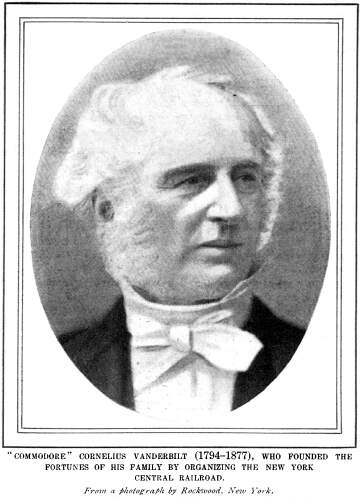 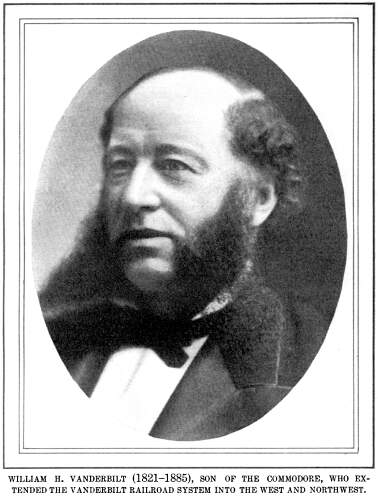
Having done this, his financial intuitions taught him that
he had materialized lurking opportunity into visible and profit
returning wealth; and it was to obtain marketable evidences of
his success that he by one stroke of the pen added forty millions
to the capital of his system. That was financing. Some called
it watering the stock, but the public can scarcely have so esteemed
it, since in the public market that stock has, excepting in years
of depression, maintained itself at par or above.
As soon as he had perfected his system from New York to Buffalo,
the elder Vanderbilt saw that its permanent strength was to be
maintained through its mastery of connections with the metropolis
of the West, and the later years of his life were devoted to the
compassing of a secure trunk line that would command much of the
traffic that was opened up beyond Chicago.
THE CREATORS OF THE PENNSYLVANIA
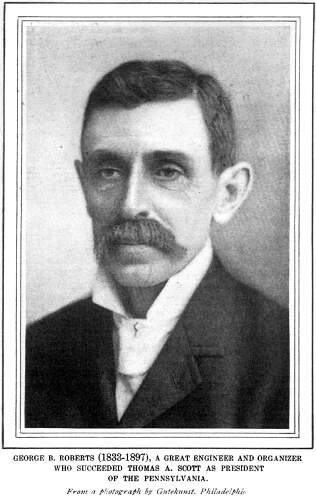 A little further south, by means
of the schooling that the theodolite and the rodman's task gave
to J. Edgar Thomson, and after him George B. Roberts, these two
men were successively approaching the executive control of the
vast Pennsylvania system. They were preeminently engineers, and
they typified the relation which science and the actual work of
railway building have had to the development of our national systems.
Between these two came Colonel Thomas A. Scott, the superb cavalry
leader of the railway army, that inspiring and magnetic genius
who during the Civil War put aside his duties to do invaluable
service to the government in transporting troops and supplies.
When the war was ended, he brought back to the Pennsylvania the
charm of his personality, and revealed his financial ability by
his part in the erection of the Pennsylvania Company, a triumph
of financial strategy whereby the control of the great railroad
is secured against the perils of speculation. All these things
combined to make of Colonel Scott the most attractive figure in
the intensely exciting railway life of his time. He was also a
masterly force as a practical operator, and he taught others many
of their best lessons. A little further south, by means
of the schooling that the theodolite and the rodman's task gave
to J. Edgar Thomson, and after him George B. Roberts, these two
men were successively approaching the executive control of the
vast Pennsylvania system. They were preeminently engineers, and
they typified the relation which science and the actual work of
railway building have had to the development of our national systems.
Between these two came Colonel Thomas A. Scott, the superb cavalry
leader of the railway army, that inspiring and magnetic genius
who during the Civil War put aside his duties to do invaluable
service to the government in transporting troops and supplies.
When the war was ended, he brought back to the Pennsylvania the
charm of his personality, and revealed his financial ability by
his part in the erection of the Pennsylvania Company, a triumph
of financial strategy whereby the control of the great railroad
is secured against the perils of speculation. All these things
combined to make of Colonel Scott the most attractive figure in
the intensely exciting railway life of his time. He was also a
masterly force as a practical operator, and he taught others many
of their best lessons.
Later, Colonel Scott turned from his triumphs in Pennsylvania
to what he deemed to be greater possibilities, the construction
of a railroad from the Gulf of Mexico to a harbor upon the Pacific.
All that he possessed was in this enterprise. His faith in it
was supreme, but he did not live to see that faith justified.
It remained for Jay Gould, who was the first to teach what profit
there might be in the speculative mastery and utilization of railroads,
to take the burden of this Texas Pacific from the shoulders of
Colonel Scott.
It was J. Edgar Thomson's experience as an engineer that led
him, a few years after the close of our Civil War, to import from
England what he called ten miles of steel rails. The cost of these
rails was a hundred and sixty six dollars a ton, and yet Mr. Thomson
did not regard the price as prohibitive provided the rails were
able to stand the traffic they were expected to bear. Four miles
of them were laid at a place where the test was severe. In spite
of certain imperfections, not inherent in the rail, they were
found to fulfill the most glowing promises, and immediately the
Pennsylvania began the equipment of its lines with steel rails,
thereby setting an example to the managers of other systems. It
soon became apparent that if the railroads were to carry the traffic
of the great West, the steel rail was an absolute necessity.
OPENING UP THE GREAT WEST
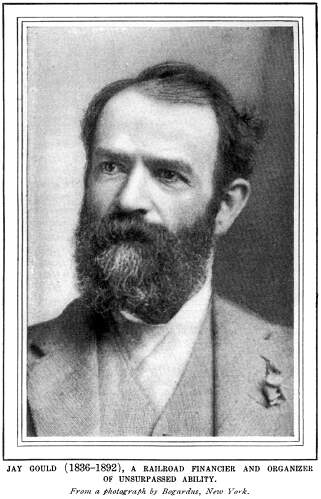 In the West, beyond Chicago and
the Mississippi, the impulse towards expansion was felt with even
greater pressure than in the East. The little railroad that ran
from Chicago to Freeport, Illinois, became the nucleus out of
which the colossal Northwestern system has expanded. One of its
earlier presidents reported that he had obtained near Elgin an
ample supply of timber for the railroad as long as it existed.
Twenty years later the general manager, J. D. Layng, reported
that this supply would not furnish enough kindling wood for the
company's locomotives for one year. In the West, beyond Chicago and
the Mississippi, the impulse towards expansion was felt with even
greater pressure than in the East. The little railroad that ran
from Chicago to Freeport, Illinois, became the nucleus out of
which the colossal Northwestern system has expanded. One of its
earlier presidents reported that he had obtained near Elgin an
ample supply of timber for the railroad as long as it existed.
Twenty years later the general manager, J. D. Layng, reported
that this supply would not furnish enough kindling wood for the
company's locomotives for one year.
President Albert Keep and his associates, mastered by this
impulse for expansion, and looking forward with the clear vision
of business statesmanship, took that railroad across the trackless
and desolate prairie full a thousand miles. After the rails had
been put down, they carried a party of friends over the new line.
When the inspection was ended, President Keep said
"Well, what do you think of it?"
His friends thought that his faith might wait many years for
justification. Within two or three years the road was transporting
westward two hundred carloads of emigrants daily. The wave of
immigration that has with almost magic celerity pushed our frontiers
further and further west, until there is no longer any frontier
excepting the Pacific, responded instantly to the faith of those
who were constructing railways over the prairies. The vast uninhabited
tracts that these pioneers penetrated are today sending the fruit
of their majestic harvests, valued at many millions, to feed their
own countrymen and much of Europe.
A similar inspiration impelled C. P. Huntington upon the Pacific
Slope, and James J. Hill in the far North, to dare, one from westward
to eastward and the other from eastward to westward, to civilize
great unpeopled regions with their steel rails. Mr. Huntington
was trained a trader. He would have made a great merchant, and
was in fact a successful one before he became a railway constructor
upon a grand scale. He was also of high financial capacity. Mr.
Hill went from the humblest of vocations to the details of transportation,
and was therefore well fitted for the practical work of operation.
He carried his nerves and enthusiasms upon the surface, while
Huntington concealed his. The philosophy of both was the same,
but its expression in speech and mannerisms and personality was
very different.
Mr. Hill persuaded men so well that some of the great bankers
of New York encouraged him with counsel and with funds, after
he had demonstrated the feasibility of developing a little railway
in Minnesota to a transcontinental line. Mr. Huntington was in
great measure—partly through the aid of the government, for
he was a master politician—his own financier.
OTHER GREAT RAILROAD BUILDERS
Henry Villard, whose name is identified with the completion
of the Northern Pacific system, should rank with those who have
financed large railway propositions rather than with the great
operators, engineers, or discoverers of hidden possibilities in
the opening up of vast tracts. Mr. Villard made the completion
of the Northern Pacific possible, and the fact that he was able
to recover his power after having lost it by reason of the storms
of 1884 justifies his title to a place among masterful railway
financiers.
Jay Gould combined to a remarkable degree the three qualities
which in their highest development have made our American railroads
what they are. He ranked with the ablest of financiers, and often
showed his ability in financing railroads both into and out of
difficulties. His demoralizing methods, however, were abandoned
early in life. His training as an engineer and surveyor, the statesmanlike
vision which caused him to comprehend the possibilities of the
Southwest, impelled him while still a young man to undertake the
creation of a great Southwestern railway system. He lived long
enough to inspire his son, George J. Gould, with his own enthusiasm,
not long enough to witness the fruition of his ambition. The son,
today master of a steel network that covers the great Southwest,
has turned his eyes towards the East. At first a cautious conservator
of the properties left to him by his father, he now seems to feel
himself strong enough to bring his railway system across the Alleghanies
to the seaboard.
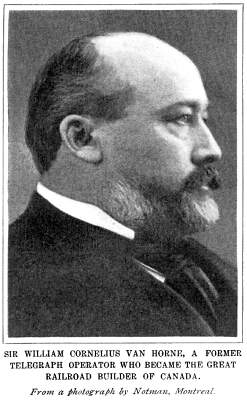 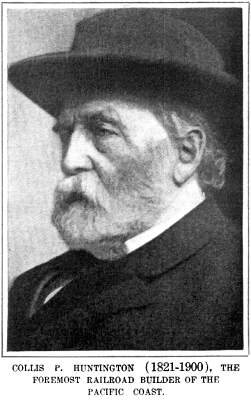
Canada, official Canada, imperial Canada, perceiving the development
of the republic to the south of her, sharing the British yearning
for an independent route to the far east, undertook, as a great
national work, a transcontinental system reaching from the Atlantic
at Halifax to the Pacific at Vancouver.
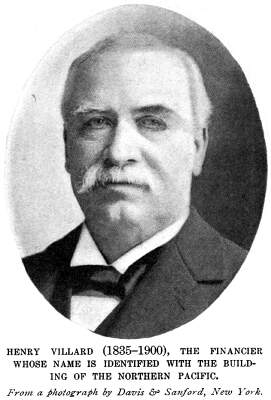 William Van Horne, trained in railway
service as a telegrapher in Illinois, and from that by successive
steps attaining rank with the greatest of engineers and of executive
forces, was called to Canada that this Canadian Pacific might
be speedily and well completed. For this service he was knighted,
and he is today contemplating a supplement to it through the opening
up of a national railway system in Cuba. He is eminently an executive,
an operator, and an engineer. William Van Horne, trained in railway
service as a telegrapher in Illinois, and from that by successive
steps attaining rank with the greatest of engineers and of executive
forces, was called to Canada that this Canadian Pacific might
be speedily and well completed. For this service he was knighted,
and he is today contemplating a supplement to it through the opening
up of a national railway system in Cuba. He is eminently an executive,
an operator, and an engineer.
The great era of railway construction for the United States,
at least for through lines, ended in the middle eighties. From
1885 until 1895 the country was digesting its enormous expenditures
of capital, liquidating the colossal debt which they created in
foreign markets, and waiting for the rich development of the new
lands the railroads furrowed. A year or two later there were the
first hints of what is to be the new era of railway development
in the United States.
THE DAY OF VAST COMBINATIONS
For twenty years the tendency had been to assimilate collateral
lines, small branches and feeders, into comprehensive systems,
so that the traffic of territory penetrated by a railroad could
be protected. But competition had entailed vast wastage and demoralization,
and when the courts and the legislatures declared that certain
agreements like those of the Joint Traffic Association and the
Trans Missouri Association were illegal, it became clear that
either there must be some radical departure, or ultimately the
government itself must be the owner of the railroads.
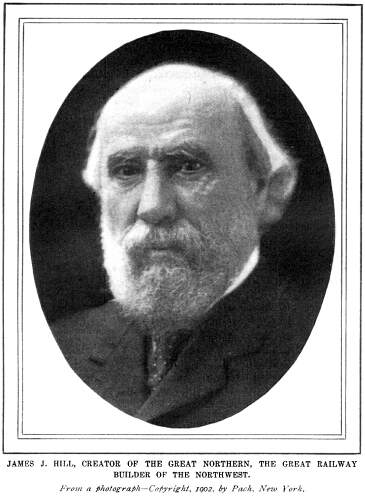 This came at a time when, by reason
or the revival of business activity, and of an enormous excess
of exports over imports—itself made possible by our railroad
expansion—there was a great increase of surplus capital in
the United States. Intuitively, tentatively, there began the new
development, which was the combination of great systems within
certain zones into one control, either sympathetic or direct—"the
community of interest," as it was termed. This came at a time when, by reason
or the revival of business activity, and of an enormous excess
of exports over imports—itself made possible by our railroad
expansion—there was a great increase of surplus capital in
the United States. Intuitively, tentatively, there began the new
development, which was the combination of great systems within
certain zones into one control, either sympathetic or direct—"the
community of interest," as it was termed.
This movement brought a remarkable group of constructive financiers—Edward
Harriman in the far West, the Rockefellers and James Stillman,
of New York, and especially J. Pierpont Morgan—into the higher
activities of railway expansion. Dominated by the men already
named, and by Mr. Speyer and Mr. Schiff, private bankers of New
York, by George F. Baker, by George Gould and Russell Sage, by
the Belmonts, representing the Rothschilds, and by the financial
interests that are identified with the Vanderbilt name, this movement
seems inevitably to point to the concentration of all our railroads
into five or six vast groups. Each group will control its own
zone—in some cases intersected by the parallels of latitude,
and in others by those of longitude. By this new system, say its
organizers, ruinous competition shall be finally ended, and we
shall see a demonstration of that true law of business prosperity
which teaches how to obtain the greatest market and the greatest
productive activity. Modern industrial science tells us that these
things can be assured only by working with the utmost economy
and at the lowest prices consistent with fair profit.
Stories Page | Contents Page
|







